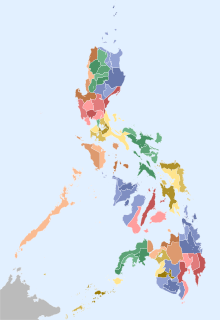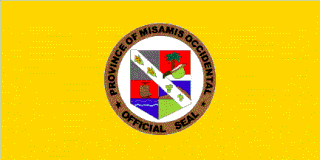
The provinces of the Philippines are the primary political and administrative divisions of the Philippines. There are 81 provinces at present, further subdivided into component cities and municipalities. The local government units in the National Capital Region, as well as independent cities, are independent of any provincial government. Each province is governed by an elected legislature called the Sangguniang Panlalawigan and an elected governor.

Misamis Occidental is a province located in the region of Northern Mindanao in the Philippines. Its capital is the city of Oroquieta. The province borders Zamboanga del Norte and Zamboanga del Sur to the west and is separated from Lanao del Norte by Panguil Bay to the south and Iligan Bay to the east. The province of Misamis was originally inhabited by Subanens who were an easy target by the sea pirates from Lanao.

Lanao del Norte officially the Province of Lanao del Norte, is a province in the Philippines located in the Northern Mindanao region. Its capital is Tubod.

Lanao del Sur, officially the Province of Lanao del Sur, is a province in the Philippines located in the Bangsamoro Autonomous Region in Muslim Mindanao (BARMM). The capital is the city of Marawi, and it borders Lanao del Norte to the north, Bukidnon to the east, and Maguindanao and Cotabato to the south. To the southwest lies Illana Bay, an arm of the Moro Gulf.

The Autonomous Region in Muslim Mindanao was an autonomous region of the Philippines, located in the Mindanao island group of the Philippines, that consisted of five predominantly Muslim provinces: Basilan, Lanao del Sur, Maguindanao, Sulu, and Tawi-Tawi. It was the only region that had its own government. The region's de facto seat of government was Cotabato City, although this self-governing city was outside its jurisdiction.

The legislative district of Mindanao and Sulu was the collective representation of the Department of Mindanao and Sulu and its component provinces of Agusan, Bukidnon, Cotabato, Davao, Lanao, Sulu and Zamboanga as a single at-large district in the lower house of the Philippine Legislature from 1916 until 1935.
The legislative district of Agusan was the representation of the historical province of Agusan in the various national legislatures of the Philippines until 1969. Butuan also remained part of the province's representation even after becoming a chartered city in 1950.
The legislative district of Zamboanga was the representation of the historical province of Zamboanga in the various national legislatures of the Philippines until 1953. The undivided province's representation encompassed the present-day provinces of Basilan, Zamboanga del Norte, Zamboanga del Sur and Zamboanga Sibugay, and the highly urbanized city of Zamboanga.
The legislative district of Iligan is the representation of the highly urbanized city of Iligan in the Congress of the Philippines. The city is currently represented in the lower house of the Congress through its lone congressional district.
The legislative districts of Zamboanga del Norte are the representations of the province of Zamboanga del Norte in the various national legislatures of the Philippines. The province is currently represented in the lower house of the Congress of the Philippines through its first, second and third congressional districts.
The legislative districts of Zamboanga del Sur are the representations of the province of Zamboanga del Sur in the various national legislatures of the Philippines. The province is currently represented in the lower house of the Congress of the Philippines through its first and second congressional districts.
The legislative districts of Sulu are the representations of the province of Sulu in the various national legislatures of the Philippines. The province is currently represented in the lower house of the Congress of the Philippines through its first and second congressional districts.
The legislative district of Davao del Sur is the representation of the province of Davao del Sur in the various national legislatures of the Philippines. The province is currently represented in the lower house of the Congress of the Philippines through its lone congressional district.
The legislative district of Davao was the representation of the historical province of Davao in the various national legislatures of the Philippines until its dissolution in 1967.
The legislative districts of Cotabato are the representations of the province of Cotabato in the various national legislatures of the Philippines. The province is currently represented in the lower house of the Congress of the Philippines through its first, second, and third congressional districts.
The legislative districts of Lanao del Norte are the representations of the province of Lanao del Norte in the various national legislatures of the Philippines. The province is currently represented in the lower house of the Congress of the Philippines through its first and second congressional districts.
The legislative districts of Lanao del Sur are the representations of the province of Lanao del Sur in the various national legislatures of the Philippines. The province is currently represented in the lower house of the Congress of the Philippines through its first and second congressional districts.
General elections are held for the first time in the newly created Autonomous Region in Muslim Mindanao for the Regional Governor and Vice-Governor were held on February 12, 1990. The Autonomous Region in Muslim Mindanao region was first created on August 1, 1989 through Republic Act No. 6734 otherwise known as the Organic Act in pursuance with a constitutional mandate to provide for an autonomous area in Muslim Mindanao. A plebiscite was held in the provinces of Basilan, Cotabato, Davao del Sur, Lanao del Norte, Lanao del Sur, Maguindanao, Palawan, South Cotabato, Sultan Kudarat, Sulu, Tawi-Tawi, Zamboanga del Norte and Zamboanga del Sur; and in the cities of Cotabato, Dapitan, Dipolog, General Santos, Iligan, Marawi, Pagadian, Puerto Princesa and Zamboanga to determine if the residents would want to be part of the ARMM. Of the areas where the plebiscites were held only Lanao del Sur, Maguindanao, Sulu and Tawi-Tawi voted favorably for inclusion in the new autonomous region.

Misamis is a former province of the Philippines. It corresponds to the present provinces of Misamis Occidental, Misamis Oriental, Camiguin, Bukidnon, part of Zamboanga del Norte, Lanao del Sur and Lanao del Norte, and part of Cotabato.
Lanao Province was one of the former provinces of the Philippines from 1914 to 1959. Today, the province comprises Lanao del Norte and Lanao del Sur.







